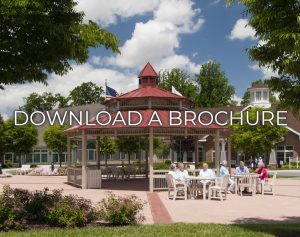Retirement is a time to rest on your laurels and enjoy a more carefree and fun lifestyle. With more time than ever, you can do all the things you have always wanted to do (e.g. travel, pursue hobbies, take classes or volunteer). When considering aging at home or in a senior living community, don’t forget to look at how you will maintain your lifestyle in the future.
The costly realities of aging at home
Home is where the heart is. It is also a place that needs constant upkeep and repair, which can become costly and burdensome as you age. All the simple tasks like mowing the lawn or shoveling snow become more difficult, and appliances need repairing or replacing, as do roofs and plumbing. Then there are the monthly costs – mortgage, insurance, utilities, taxes, security and other monthly expenses.
Much of these costs are bundled into one monthly fee based on the housing option you choose. Combined with services and amenities (e.g. chef-prepared meals, daily social and wellness activities, local transportation, library, woodshop, building and ground maintenance) senior living communities offer a better value. Learn more from our Cost of Senior Living Versus Aging at Home.
Changing needs
Even if you’re healthy and active going into retirement, it is fair to anticipate that at some point you’ll need help. While it is human nature to resist admitting this and to dismiss it, according to the Association for Long Term Care Planning’s Long Term Care Facts and Statistics, 70 percent of seniors age 65 or older will eventually need long-term care. If you’re lucky, family or friends can lend a hand, but that may not be possible as your care needs increase.
Continuum of care is a major benefit of living in a continuing care retirement community (i.e. life-plan community). Like Carroll Lutheran Village, CCRCs offer different levels of care within one senior living community. You can enjoy independent living in your choice of modern housing, with the ability to move to a higher level of care (e.g. assisted living, memory care, skilled nursing) as needed. Best of all, in a CCRC, you are at the top of the list so can receive the care you need without having to move and leave friends behind. Read our information on Continuing Care Retirement Communities (CCRC): How to Choose for more information on CCRCs.
Mobility loss and isolation
Another factor for you to consider is mobility loss. As you find it more challenging to get out and about, you increase the risk of isolation. If visiting friends, shopping and attending events become difficult, you’ll quickly find yourself choosing to stay home, greatly reducing your social interaction. Isolation can take a toll on your physical and mental health. According to the Centers for Disease Control and Prevention’s Loneliness and Social Isolation Linked to Serious Health Conditions, health consequences include higher risk of dementia, heart disease, stroke, depression, anxiety, suicide and premature death.
Moving to a senior living community where everything is close by will not only help you minimize mobility problems, but it will also keep you connected to others through shared events, activities and other social opportunities. It is also a fact that socialization and cognitive engagement can help you stay healthy, live longer and improve memory.
Safety and security
Staying safe and secure while you’re aging in place at home can become a challenge. Climbing stairs, moving through small hallways or other cramped areas and performing everyday tasks gets harder over time. While there are things you can do to make a home safer, like removing throw rugs, moving bedrooms to a lower level and adding ramps and grab bars, those adjustments can be virtually free or very costly.
Modern senior living communities are designed for absolute accessibility and safety. Whether you can manage with or without an assistive device (e.g. walker, wheelchair), you can go where you want easily. With falls being the most dangerous threat to seniors, the open space offered by senior living communities can be a real lifesaver. Of course, senior living communities are also secure. You can rest easy knowing you and your home are protected, 24/7 year-round!
Peace of mind is likely one of the most important reasons for considering a senior living community over aging at home. Knowing that in a senior living community you are not a burden to anyone and living independently on your own terms for as long as your able is a satisfying feeling.
Deciding how long to stay in your home and when to move to a senior living community, requires a lot of thought and understanding of information. Depending on the care you need as you grow older, your home may no longer be a feasible or safe place to live, your risk of isolation may increase and at home care may be more expensive than a senior living community.
Download our Stay or Go Guide for more senior living information to make the right choice.






